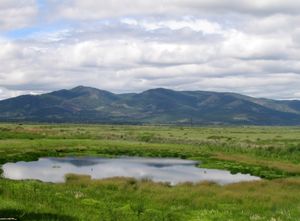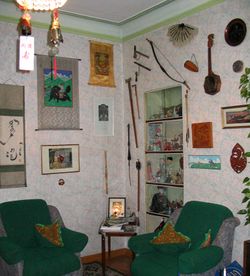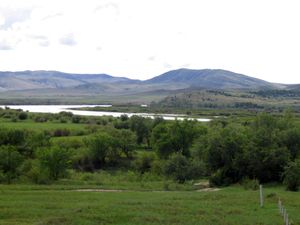Buryatia
| Republic of Buryatia (English) Республика Бурятия (Russian) Буряад Республика (Buryat) |
|
|---|---|
| - Republic - | |
.svg.png) |
|
 Coat of arms of the Republic of Buryatia |
 Flag of the Republic of Buryatia |
| Anthem | National Anthem of the Republic of Buryatia |
| Political status | |
| Country | Russia |
| Political status | Republic |
| Federal district | Siberian[1] |
| Economic region | East Siberian[2] |
| Capital | Ulan-Ude |
| Official languages | Russian[3]; Buryat[4] |
| Statistics | |
| Population (2002 Census)[5] | 981,238 inhabitants |
| - Rank within Russia | 56th |
| - Urban[5] | 59.6% |
| - Rural[5] | 40.4% |
| - Density | 2.79 /km2 (7.2 /sq mi)[6] |
| Area (as of the 2002 Census)[7] | 351,300 km2 (135,637.7 sq mi) |
| - Rank within Russia | 15th |
| Established | May 30, 1923 |
| License plates | 03 |
| ISO 3166-2:RU | RU-BU |
| Time zone | IRKT/IRKST (UTC+8/+9) |
| Government (as of October 2008) | |
| President[8] | Vyacheslav Nagovitsyn[9] |
| Legislature | People's Khural[8] |
| Constitution | Constitution of the Republic of Buryatia |
| Official website | |
| http://egov-buryatia.ru/ | |
The Republic of Buryatia (Russian: Респу́блика Буря́тия, Respublika Buryatiya; Buryat: Буряад Республика, Buryaad Respublika) is a federal subject of Russia (a republic). Its area is slightly over 350,000 km² with a population of almost one million. Its capital is Ulan-Ude.
Contents |
Geography

The republic is located in the South-Central region of Siberia along the eastern shore of Lake Baikal.
- Area: 351,300 km²
- Borders:
- internal: Irkutsk Oblast (W/NW/N), Chita Oblast (NE/E/SE/S), Tuva (W)
- international: Mongolia (S/SE)
- water: Lake Baikal (N)
- Highest point: Mount Munku-Sardyk (3,491 m)
Rivers
Major rivers include:
- Barguzin River
- Irkut River
- Kitoy River
- Oka River
- Selenga River
- Uda River
- Upper Angara River
- Vitim River
Lakes
- Lake Baikal - Buryatia covers sixty percent of the lake's shore line
- Lake Gusinoye
Mountains
Over 80% of the republic's territory is located in the mountainous region, including the Baikal Mountains on the northern shores of Lake Baikal.
Natural resources
The republic's natural resources include gold, tungsten, zinc, uranium, and more.
Climate
- Average annual temperature: −1.6 °C (29.1 °F)
- Average January temperature: −22 °C (−7.6 °F)
- Average July temperature: +18 °C (64.4 °F)
- Average annual precipitation: 244 millimeters (9.6 in)
Administrative divisions
Demographics

- Population: 981,238 (2002)
- Urban: 584,970 (59.6%)
- Rural: 396,268 (40.4%)
- Male: 467,984 (47.7%)
- Female: 513,254 (52.3%)
- Females per 1000 males: 1,097
- Average age: 31.6 years
- Urban: 31.2 years
- Rural: 32.2 years
- Male: 29.4 years
- Female: 33.9 years
- Number of households: 322,289 (with 958,402 people)
- Urban: 197,651 (with 566,755 people)
- Rural: 124,638 (with 391,647 people)
- Vital statistics
- Source: Russian Federal State Statistics Service]
| Births | Deaths | Birth rate | Death rate | |
|---|---|---|---|---|
| 1970 | 14,766 | 6,301 | 18.1 | 7.7 |
| 1975 | 17,751 | 7,586 | 20.6 | 8.8 |
| 1980 | 19,859 | 8,734 | 21.6 | 9.5 |
| 1985 | 23,975 | 9,529 | 24.1 | 9.6 |
| 1990 | 19,185 | 9,602 | 18.3 | 9.1 |
| 1991 | 16,868 | 9,753 | 16.0 | 9.3 |
| 1992 | 13,944 | 10,347 | 13.3 | 9.9 |
| 1993 | 11,981 | 12,388 | 11.5 | 11.9 |
| 1994 | 12,327 | 13,650 | 11.9 | 13.1 |
| 1995 | 12,311 | 12,588 | 11.9 | 12.2 |
| 1996 | 12,159 | 12,441 | 11.8 | 12.1 |
| 1997 | 11,555 | 12,111 | 11.3 | 11.8 |
| 1998 | 11,746 | 11,481 | 11.6 | 11.3 |
| 1999 | 11,468 | 13,114 | 11.4 | 13.0 |
| 2000 | 11,654 | 13,155 | 11.6 | 13.1 |
| 2001 | 11,678 | 13,858 | 11.8 | 14.0 |
| 2002 | 12,830 | 14,404 | 13.0 | 14.6 |
| 2003 | 13,177 | 15,056 | 13.5 | 15.4 |
| 2004 | 13,399 | 14,868 | 13.8 | 15.3 |
| 2005 | 13,551 | 15,144 | 14.0 | 15.7 |
| 2006 | 14,193 | 13,930 | 14.8 | 14.5 |
| 2007 | 15,460 | 12,802 | 16.1 | 13.3 |
| 2008 | 16,372 | 12,948 | 17.0 | 13.5 |
- Ethnic groups
According to the 2002 Census, ethnic Russians make up two thirds of the republic's population, while the ethnic Buryats are only 27.8%. Other groups include Ukrainians (1.0%), Tatars (0.8%), and a host of smaller groups, each accounting for less than 0.5% of the total population.
| 1926 census 1 | 1939 census | 1959 census | 1970 census | 1979 census | 1989 census | 2002 census | |
|---|---|---|---|---|---|---|---|
| Buryats | 214,957 (43.8%) | 116,382 (21.3%) | 135,798 (20.2%) | 178,660 (22.0%) | 206,860 (23.0%) | 249,525 (24.0%) | 272,910 (27.8%) |
| Soyots | 161 (0.0%) | 2,739 (0.3%) | |||||
| Russians | 258,796 (52.7%) | 393,057 (72.0%) | 502,568 (74.6%) | 596,960 (73.5%) | 647,785 (72.0%) | 726,165 (69.9%) | 665,512 (67.8%) |
| Ukrainians | 1,982 (0.4%) | 13,392 (2.5%) | 10,183 (1.5%) | 10,769 (1.3%) | 15,290 (1.7%) | 22,868 (2.2%) | 9,585 (1.0%) |
| Tatars | 3,092 (0.6%) | 3,840 (0.7%) | 8,058 (1.2%) | 9,991 (1.2%) | 10,290 (1.1%) | 10,496 (1.0%) | 8,189 (0.8%) |
| Evenks | 2,808 (0.6%) | 1,818 (0.3%) | 1,335 (0.2%) | 1,685 (0.2%) | 1,543 (0.2%) | 1,679 (0.2%) | 2,334 (0.2%) |
| Others | 9,440 (1.9%) | 17,277 (3.2%) | 15,384 (2.3%) | 14,186 (1.7%) | 17,630 (2.0%) | 27,519 (2.7%) | 19,969 (2.0%) |
- In 1926, the Buryat-Mongolian ASSR included Aga-Buryatia, Ust-Orda Buryatia, and Olkhonsky District. These territories were transferred to Chita and Irkutsk Oblasts in 1937. Consequently, the results of the 1926 Census cannot be compared to the results of the censuses of 1939 and later.
Demographics for 2007 [1]
| District | Births | Deaths | Growth | Pp (2007) | BR | DR | NGR |
|---|---|---|---|---|---|---|---|
| The Republic of Buryatia | 12,337 | 9,833 | 2,504 | 960,000 | 17.13 | 13.66 | 0.35% |
| Ulan-Ude | 4,260 | 3,517 | 743 | 373,300 | 15.22 | 12.56 | 0.27% |
| Bichursky District | 339 | 318 | 21 | 26,900 | 16.80 | 15.76 | 0.10% |
| Dzhidinsky District | 512 | 309 | 203 | 30,800 | 22.16 | 13.38 | 0.88% |
| Yeravninsky District | 244 | 191 | 53 | 18,600 | 17.49 | 13.69 | 0.38% |
| Zaigrayevsky District | 714 | 630 | 84 | 48,700 | 19.55 | 17.25 | 0.23% |
| Zakamensky District | 492 | 322 | 170 | 30,400 | 21.58 | 14.12 | 0.75% |
| Ivolginsky District | 498 | 320 | 178 | 31,000 | 21.42 | 13.76 | 0.77% |
| Kabansky District | 702 | 779 | -77 | 64,400 | 14.53 | 16.13 | -0.16% |
| Kizhinginsky District | 303 | 192 | 111 | 18,700 | 21.60 | 13.69 | 0.79% |
| Kyakhtinsky District | 629 | 393 | 236 | 40,500 | 20.71 | 12.94 | 0.78% |
| Mukhorshibirsky District | 338 | 319 | 19 | 28,000 | 16.10 | 15.19 | 0.09% |
| Pribaykalsky District | 423 | 357 | 66 | 28,900 | 19.52 | 16.47 | 0.30% |
| Selenginsky District | 628 | 522 | 106 | 47,500 | 17.63 | 14.65 | 0.30% |
| Tarbagataysky District | 205 | 216 | -11 | 16,900 | 16.17 | 17.04 | -0.09% |
| Tunkinsky District | 304 | 249 | 55 | 23,000 | 17.62 | 14.43 | 0.32% |
| Khorinsky District | 314 | 222 | 92 | 19,200 | 21.81 | 15.42 | 0.64% |
| Barguzinsky District | 367 | 272 | 95 | 25,600 | 19.11 | 14.17 | 0.49% |
| Bauntovsky Evenkiysky District | 126 | 92 | 34 | 10,500 | 16.00 | 11.68 | 0.43% |
| Kurumkansky District | 232 | 129 | 103 | 15,600 | 19.83 | 11.03 | 0.88% |
| Muysky District | 179 | 112 | 67 | 15,600 | 15.30 | 9.57 | 0.57% |
| Okinsky District | 73 | 37 | 36 | 5,100 | 19.08 | 9.67 | 0.94% |
| Severo-Baykalsky District | 196 | 161 | 35 | 15,200 | 17.19 | 14.12 | 0.31% |
| Severobaykalsk | 259 | 174 | 85 | 25,600 | 13.49 | 9.06 | 0.44% |
History
The area of the present-day Buryatia was first colonized in the 17th century by Russians in search of wealth, furs, and gold. In 1923, the Buryat-Mongolian Autonomous Soviet Socialist Republic was created as a result of the merger of Buryat-Mongol and Mongol-Buryat Oblasts. In 1937, Aga Buryatia and Ust-Orda Buryatia were detached from the Buryat-Mongolian ASSR and merged with Chita and Irkutsk Oblasts, respectively. Besides, Olkhonsky District was transferred from the Buryat-Mongolina ASSR to Irkutsk Oblast.
Politics

The head of the government is the President, who is appointed by the President of Russia for a four-year term. Between 1991-2007, the President was Leonid Vasilyevich Potapov, who was elected on July 1, 1994, re-elected in 1998 (with 63.25% of votes), and then re-elected again on June 23, 2002 (with over 67% of votes). Prior to the elections, Potapov was the Chairman of the Supreme Soviet of the Republic—the highest post at that time.
The Republic's parliament is the People's Khural, popularly elected every four years. The People's Khural has 65 deputies. Alexander Lubsanov is the current Chairman of the People's Khural since 2002.
The Republic's Constitution was adopted on February 22, 1994.
Economy
The republic's economy is composed of important agricultural and commercial products including wheat, vegetables, potatoes, timber, leather, graphite, and textiles. Fishing, hunting, fur farming, sheep and cattle farming, mining, stock raising, engineering, and food processing are also important economic generators.
Education
The higher education institutions of the republic include Buryatia State University, Buryat State Academy of Agriculture, East Siberian State Academy of Arts and Culture, and East Siberian State Technological Institute.
Religion

Tibetan Buddhism, Shamanism, and Orthodox Christianity are the most widespread religions in the republic.
Tourism
Lake Baikal is a popular tourist destination, especially in summer.
See also
- Music of Buryatia
References
- ↑ Президент Российской Федерации. Указ №849 от 13 мая 2000 г. «О полномочном представителе Президента Российской Федерации в федеральном округе». Вступил в силу 13 мая 2000 г. Опубликован: "Собрание законодательства РФ", №20, ст. 2112, 15 мая 2000 г. (President of the Russian Federation. Decree #849 of May 13, 2000 On the Plenipotentiary Representative of the President of the Russian Federation in a Federal District. Effective as of May 13, 2000).
- ↑ Госстандарт Российской Федерации. №ОК 024-95 27 декабря 1995 г. «Общероссийский классификатор экономических регионов. 2. Экономические районы», в ред. Изменения №5/2001 ОКЭР. (Gosstandart of the Russian Federation. #OK 024-95 December 27, 1995 Russian Classification of Economic Regions. 2. Economic Regions, as amended by the Amendment #5/2001 OKER. ).
- ↑ According to Article 68.1 of the Constitution of Russia, Russian is the official language on the whole territory of the Russian Federation. Article 68.2 further stipulates that only the republics have the right to establish official languages other than Russian.
- ↑ Constitution, Article 67
- ↑ 5.0 5.1 5.2 Федеральная служба государственной статистики (Federal State Statistics Service) (2004-05-21). "Численность населения России, субъектов Российской Федерации в составе федеральных округов, районов, городских поселений, сельских населённых пунктов – районных центров и сельских населённых пунктов с населением 3 тысячи и более человек (Population of Russia, its federal districts, federal subjects, districts, urban localities, rural localities—administrative centers, and rural localities with population of over 3,000)" (in Russian). Всероссийская перепись населения 2002 года (All-Russia Population Census of 2002). Federal State Statistics Service. http://perepis2002.ru/ct/html/TOM_01_04_1.htm. Retrieved 2010-03-01.
- ↑ The value of density was calculated automatically by dividing the 2002 Census population by the area specified in the infobox. Please note that this value may not be accurate as the area specified in the infobox is not necessarily reported for the same year as the Census (2002).
- ↑ Федеральная служба государственной статистики (Federal State Statistics Service) (2004-05-21). "Территория, число районов, населённых пунктов и сельских администраций по субъектам Российской Федерации (Territory, Number of Districts, Inhabited Localities, and Rural Administration by Federal Subjects of the Russian Federation)" (in Russian). Всероссийская перепись населения 2002 года (All-Russia Population Census of 2002). Federal State Statistics Service. http://perepis2002.ru/ct/html/TOM_01_03.htm. Retrieved 2008-10-17.
- ↑ 8.0 8.1 Constitution, Article 5.3
- ↑ Official website of the President of the Republic of Buryatia. Biography of Vyacheslav Vladimirovich Nagovitsyn
Sources
- Верховный Совет Республики Бурятия. 22 февраля 1994 г. «Республика Бурятия. Конституция», в ред. Закона №332-IV от 7 июля 2008 г. (Supreme Council of the Republic of Buryatia. February 22, 1994 Republic of Buryatia. Constitution, as amended by the Law #332-IV of July 7, 2008. ).
Further reading
- Leisse, Olaf; Utta-Kristin Leisse (September 2007). "A Siberian Challenge: Dealing with Multiethnicity in the Republic of Buryatia". Nationalities Papers 35 (4): 773–788. doi:10.1080/00905990701475178.
External links
- (English) Official website of the Republic of Buryatia
- (Russian) Official website of the Republic of Buryatia
- Official website of the Republic of Buryatia (in Buryat)
- (Russian) Buryatia.org, site about life in the Republic of Buryatia